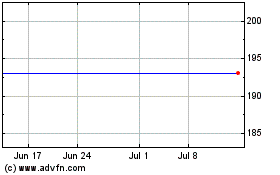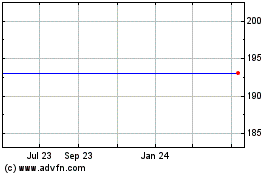By Jonathan D. Rockoff, Dana Mattioli and Lisa Beilfuss
Pfizer Inc. and Allergan PLC said Monday that they would merge
in a so-called inversion deal worth up to about $155 billion that
would create the world's biggest drug maker by sales.
The takeover would be the largest inversion ever, moving one of
the top names in corporate America to a foreign country. Such deals
enable a U.S. company to move abroad and take advantage of a lower
corporate tax rate elsewhere, and have remained popular in the face
of U.S. efforts to curb them.
The Wall Street Journal had reported the companies were on the
cusp of a deal, with terms having been hammered out, on Sunday.
To help secure a lower tax rate, the businesses of New
York-based Pfizer and Dublin-based Allergan will be combined under
Allergan, which will be renamed Pfizer PLC and trade under the
ticker symbol PFE, Pfizer's current symbol, on the New York Stock
Exchange.
Pfizer expects the combined firm to have an adjusted tax rate of
between 17% and 18%, lower than its current 25% rate, among the
highest in the industry.
Under terms of the deal, the companies will exchange 11.3 Pfizer
shares for every Allergan share, and the deal also contains a cash
component between $6 billion and $12 billion. The companies said
the deal represents a roughly 30% premium based on closing prices
Oct. 28, the day The Wall Street Journal reported the companies
were in talks.
Pfizer and Allergan said the enterprise value of the deal, which
a company spokeswoman said includes debt, is $160 billion. It is
expected to close in the second half of 2016.
Shares in both companies declined following the deal's
confirmation. Allergan's stock fell 3.2% to $302.39 and Pfizer's
stock fell 2.8% to $31.27.
Pfizer Chief Executive Ian Read will lead the combined company,
with Allergan CEO Brent Saunders serving as operating chief. The
combined board will include all 11 current Pfizer directors and
four current Allergan directors.
Mr. Read has railed against high U.S. corporate tax rates, which
he says puts American-based companies like Pfizer at a competitive
disadvantage to their overseas rivals.
The deal enables "our pursuit of business-development
opportunities on a more competitive footing within our industry,"
Mr. Read said in a news release Monday.
The deal comes days after the Treasury Department released new
rules aiming to curb tax-lowering inversion deals. Analysts said
the rules didn't appear to threaten a combination of Pfizer and
Allergan, though the risk of government action remains.
"The deal simply doesn't overlap with the new rules," said
Seamus Fernandez, director of equity research at Leerink
Partners.
The new restrictions only apply to inversions in which the U.S.
company's shareholders end up with more than 60% of the combined
entity. Pfizer said Monday that it expects Pfizer holders to own
about 56% of the merged entity, though that rate will depend on how
much cash is paid in the merger.
For the deal to go forward, the companies will have to receive
approval from antitrust regulators around the world.
The deal includes potential breakup fees of up to $3.5
billion--a high figure relative to other recent deals. For example,
Aetna Inc. and Humana Inc.'s recent $34.1 billion merger has a
potential breakup fee of $1 billion.
The merger will be neutral to Pfizer's adjusted per-share
earnings in 2017, add modestly to them in 2018 and boost them by
about 10% in 2019. By 2020, Pfizer expects the transaction to
increase adjusted profit by a high-teens percentage.
Pfizer said it expects to buy back about $5 billion in shares in
the first half of next year under an accelerated program.
The merger will create a pharmaceutical behemoth, with
top-selling products including Pfizer's Prevnar pneumonia vaccine
and Allergan's anti-wrinkle treatment Botox and industry-topping
R&D budget. The company's drugs and vaccines would cover a
range of diseases, from Alzheimer's to cancer, eye health to
rheumatoid arthritis.
The deal brings together two pharmaceutical powerhouses with
more than $60 billion in combined sales. Last year, Actavis, which
bought Allergan and took its name, had more than $13 billion in
sales, while Pfizer had nearly $50 billion in revenue.
Aside from giving Pfizer the opportunity to lower its corporate
tax rate, the deal would increase its sales growth. For Allergan,
meantime, a combination will allow it to take sales, which are
predominantly in the U.S., to other international markets.
Allergan is the result of a number of mergers in quick
succession. It started off as a company called Watson
Pharmaceuticals Inc. In 2012, Watson acquired Swiss rival Actavis
Group and adopted that name. It also absorbed Warner Chilcott PLC
and Forest Laboratories Inc. in multibillion-dollar deals.
Mr. Saunders was CEO of Forest Labs, and became CEO of Actavis
after that deal. Shortly after, Allergan's predecessor was put into
play when Valeant Pharmaceuticals International Inc. made an
unsolicited offer to buy the California company. Actavis then
stepped in as a white knight and bought Allergan, taking the
company's name.
Allergan in July agreed to sell its generics business to
Israel's Teva Pharmaceutical Industries Ltd. for more than $40
billion.
Pfizer and Allergan said that after the deal closes, the
combined company will decide on splitting into two businesses, one
focused on patent-protected products and the other on drugs that
have lost their patent protection or are close to losing it. It
expects to make that decision by the end of 2018.
Write to Jonathan D. Rockoff at Jonathan.Rockoff@wsj.com, Dana
Mattioli at dana.mattioli@wsj.com and Lisa Beilfuss at
lisa.beilfuss@wsj.com
Subscribe to WSJ: http://online.wsj.com?mod=djnwires
(END) Dow Jones Newswires
November 23, 2015 11:49 ET (16:49 GMT)
Copyright (c) 2015 Dow Jones & Company, Inc.
Allergan (NYSE:AGN)
Historical Stock Chart
From Mar 2024 to Apr 2024

Allergan (NYSE:AGN)
Historical Stock Chart
From Apr 2023 to Apr 2024
